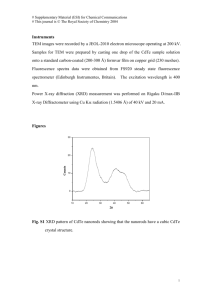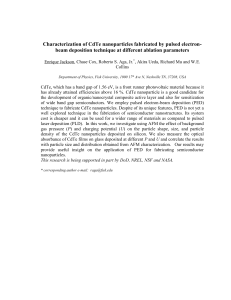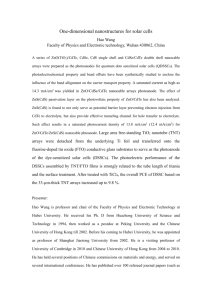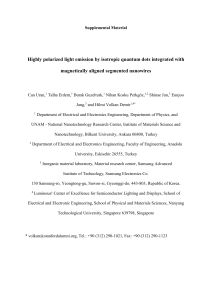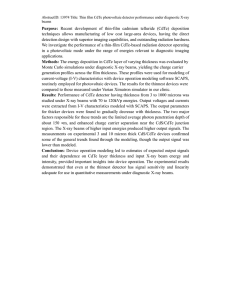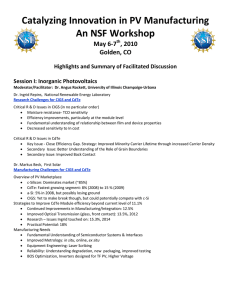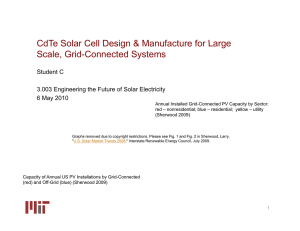markunas1_20071106.ppt
advertisement
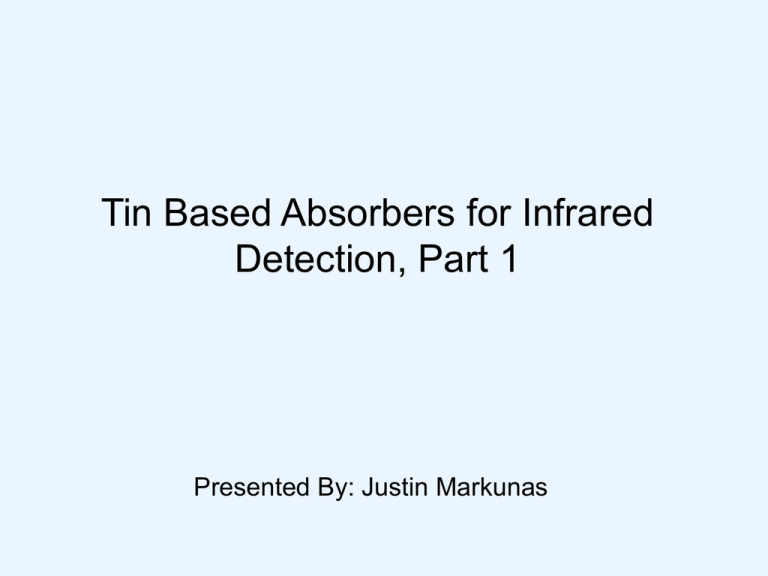
Tin Based Absorbers for Infrared Detection, Part 1 Presented By: Justin Markunas IR Detection Introduction Applications: •Military: night vision, IR target detection •Space: weather forecasting, astronomy •Industrial: quality control, failure analysis Atmospheric absorption breaks IR spectrum into several bands: •SWIR: 1.4-3mm •MWIR: 3-5 mm •LWIR: 8-12 mm •VLWIR: >12 mm Current Technology Epitaxially grown Hg(1-x)CdxTe on lattice matched Cd(1-y)ZnyTe •x-value adjusts bandgap from 0 eV (x=0) to 1.56 eV (x=1) Two color photovoltaic pixel arrays are currently being produced •Capable of 40mm pitch •Backside illumination is common (Cd(1-y)ZnyTe bandgap > 1.56eV) Advantages: •High detectivity •Able to sense the entire IR spectrum •Fast detectors due to large carrier mobilities. Disadvantages: •High cost •Difficult to process •Require cooling to operate well (especially LWIR) Competing Technologies Microbolometers •Use materials with high thermal coefficient of resistance that are heated by incident radiation •No cooling requirements •Slow Quantum Well Infrared Photodetector (QWIP) Arrays •III-V superlattices absorb IR with intraband processes •Fabricated by standard growth and processing •Absorption strength maximized at 45° angle Others (past and present) •Hg1-xCdxSi/CdTe/Si •PtSi/Si Schottky barrier diodes •Extrinsic Si and Ge photoconductors •Lead Salts (PbSnTe) •Quantum dot infrared photodetectors Basic Properties of Tin Two allotropes of Tin: White Tin (b-Phase) Gray Tin (a-Phase) •Tetragonal structure •Metallic form of tin •Cubic Structure •Semimetallic with 0 eV direct bandgap •Extremely brittle Phase Transition Occurs around 13°C •Occurs spontaneously over time Melting Point ~ 232° C Lattice Constant (a-Phase): 6.49Å Key Issues •Gray tin has a 0eV bandgap •13°C Phase Transition Bandgap Adjustment Quantum size effect •Confinement of electrons and holes changes the electronic structure •Thin film can be roughly defined as 1-D quantum square well: 2 n 2m L 2 Results from quantitative model •Peak Bandgap: .43eV •Absorption edge > 2.9mm •Drop in peak due to increased role of surface structure on electronic properties Growth of Metastable a-Sn Delaying the phase transition •Pseudomorphic epitaxial growth raises transition temperature Key requirement for pseudomorphic growth •Epilayer must be thinner than some critical thickness •Critical thickness is inversely proportional to substrate/epilayer mismatch a-Sn Grown on CdTe by MBE CdTe lattice constant: 6.482 Å (mismatch < .1%) Growth Parameters adjusted for optimal stability: •Substrate orientation •Substrate temperature •Growth rate •Total film thickness Determination of Stability: •Sample placed on hotplate under a microscope •Phase change is readily observable •Reproducible to ±1° C a-Sn Grown on CdTe by MBE Results: •Substrate orientation: both (100) and (110) provided best results •Substrate temperature: increased temperature improved stability (100-150 °C is optimal) •Growth rate: slower rate improves stability (.1-.5 mm/s) •Total film thickness: thicker films decreased stability (750-1000 Å can be achieved) •High substrate quality is critical •Highest temperature achieved before transformation: 107 °C Key Issue: •Stability is important, but IR absorption is critical •need ~2-12 mm of Sn for sufficient absorption •requires Sn/CdTe superlattices to maintain quantum size effects a-Sn/CdTe Superlattices a-Sn/CdTe superlattices were grown and their properties were monitored by RHEED CdTe 50Å a-Sn 50Å •Growth occurred at 100 °C Results: •Stable superlattices were grown for several periods •After 10 periods, quality degraded substantially •Partly due to nonideal CdTe growth conditions CdTe 50Å a-Sn 50Å CdTe 50Å a-Sn 50Å CdTe Buffer ~250Å CdTe Substrate (110) Conclusions •Thickness required for good absorption not achieved •Quality of CdTe substrates appears to be a problem •Similar experiments performed with InSb (a = 6.48 Å) showed comparable results References A. Rogalski, “Infrared Detectors: Status and Trends,” Progress in Quantum Electronics, vol. 27, pp. 59-210, 2003. S. Groves and W. Paul, “Band Structure of Gray Tin,” Physical Review Letters, vol. 11(5), pp. 194-196, Sep. 1963. F. Vnuk, A. DeMonte, and R.W. Smith, “The effect of pressure on the semiconductor-tometal transition temperature in tin and in dilute Sn-Ge alloys,” J. Appl. Phys., vol. 55(12), pp. 4171-4176, Jun. 1984. B.I. Craig and B.J. Garrison, “Theoretical examination of the quantum-size effect in thin grey-tin films,” Physical Review B, vol. 33(12), pp. 8130-8135, Jun. 1986. R.F.C. Farrow, “The stabilization of metastable phases by epitaxy,” J. Vac. Sci. Technol. B, vol. 1(2), pp. 222-228, Apr.-Jun. 1983. J.L. Reno, “Effect of growth conditions on the stability of a-Sn grown on CdTe by molecular beam epitaxy,” Appl. Phys. Lett., vol. 54(22), pp. 2207-2209, May 1989. H. Höchst, D.W. Niles, and I.H. Calderon, “Interface and growth studies of aSn/CdTe(110) superlattices,” J. Vac. Sci. Technol. B, vol. 6(4), pp. 1219-1223, Jul.-Aug. 1988.
